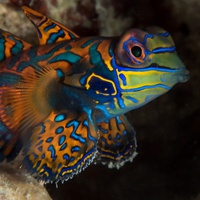The importance of colour
Redmap Team.
Decoration and display, warning and deception, or camouflage from predators…. colour is an important feature for fishes!
Animals use colour for a variety of communication purposes, including to attract mates, parent-young communication, recognizing individuals, defending territories, exhibiting aggression, camouflage, and warning predators of secondary defences such as poisons (Cheney et al, 2013, Verdes et al, 2015). Colour can also contribute to functions such as body temperature regulation and protection from sunlight (Verdes et al, 2015)..jpg)
Although colour is extremely important in the animal world – it’s not something that we rely solely on when recognizing/identifying fish species – and that’s because it’s so variable and some fish are able to change colour instantly.
There are often vast differences in colour between juveniles, males, and females of the same species. This is even the case for some of the species listed on Redmap (see Fig 1; White-Ear (Parma microlepis), Coral pigfish (Bodianus axillaris).
In addition, rapid colour changes may occur during feeding, courtship, fleeing, or the fish is taken out of water. A number of fish also exhibit vastly different day vs night colouration!
MIMICRY
Mimicry – copying the colour and or patterns and behaviour of another species. A number of fish (and other animals and plants!) use colour and pattern mimicry to avoid recognition - for example mimicking a poisonous species to reduce the chances of being eaten.
It’s thought that around 60 marine coral reef fish use mimicry (Moland et al 2005). Mimics are most common in the families Blenniidae, Serranidae and Apogonidae and models (i.e. the fish they are mimicking) occur in the families Pomacentridae, Blenniidae and Labridae (Moland et al 2005). And as in humans, this occurs mostly in the juvenile stages... something anyone with siblings will have experienced at some point in their childhood!
There are 4 main types of mimicry:
- harmless species resembling poisonous species;
- two unpalatable species looking similar to reinforce the message to predators;
- predator resembling a harmless species; and
- associating with similar colours to escape the attention of predators.
One species – aptly named the Mimic surgeonfish (Acanthurus pyroferus) even takes it a step further (there’s always one!). Juveniles of this species mimic different pygmy angelfish – depending on where they occur (Centropyge flavissima, C. heraldi, C. vrolikii; see Fig 2).
So when you’re next trying to identify a species – make sure you first take note of things like body shape, fin shape and number, any obvious features (spines etc.)….and then colour!
 (5).jpg)
References and further reading:
- Cheney, K.L., Newport, C., McClure, E.C., Marshall, N.J (2013). Colour vision and response bias in a coral reef fish. The Journal of Experimental Biology, 216, 2967-2973
- Dianne J. Bray, Acanthurus pyroferus in Fishes of Australia, accessed 18 Apr 2018, http://fishesofaustralia.net.au/home/species/1030
- Fish FAQ: Can fishes change colour https://australianmuseum.net.au/can-fishes-change-colour
- Mimic Surgeonfish, Acanthurus pyroferus: https://reeflifesurvey.com/species/1899/
- Moland E, Eagle JA, Jones GP. (2005). Ecology and evolution of mimicry in coral reef fishes, Oceanography and Marine Biology Annual Review, 2005, vol. 43 (pg. 455-482)
- Verdes, A., Cho, W., Hossain, M., Brennan, P.L.R., Hanley, D., Grim, T., Hauber, M.E. Holford, M. (2015). Nature’s Palette: Characterization of Shared Pigments in Colorful Avian and Mollusk Shells. PLoS One, 10 (12) 1-13.
- Redmap: http://www.redmap.org.au/species/1/145/ http://www.redmap.org.au/species/1/24/
- http://www.coralworld.co.il/en/children-reef-kingdom/fish-camouflage/












